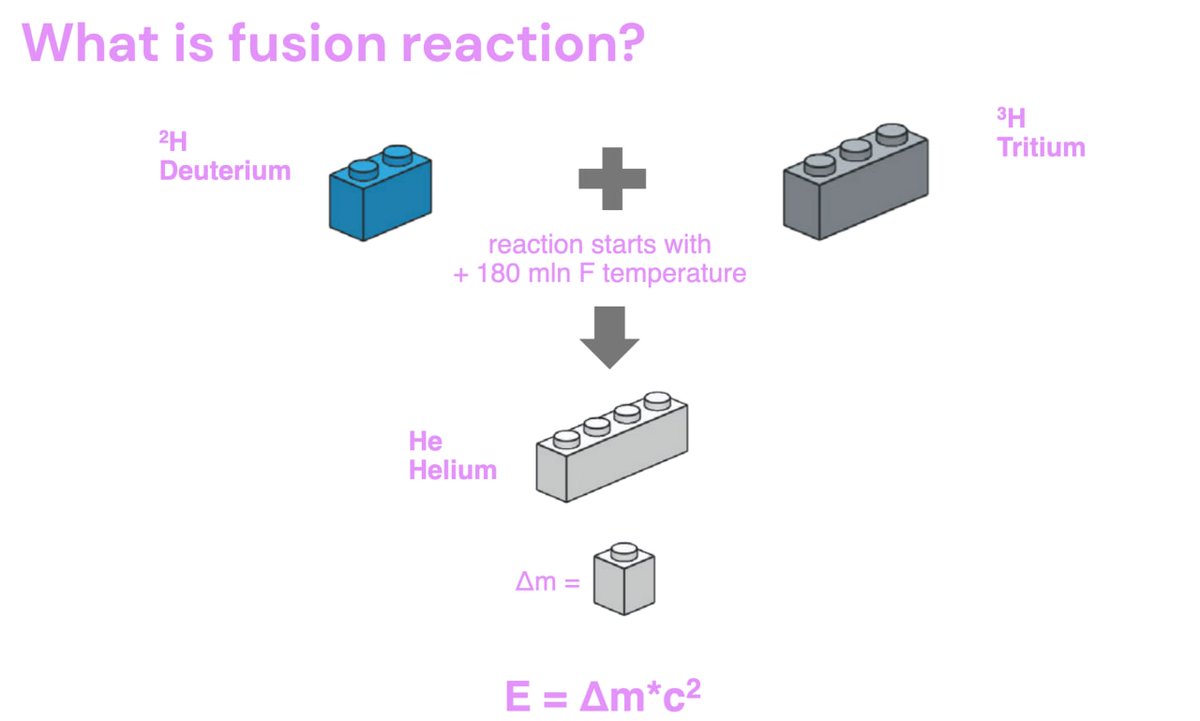
I've got the great one from @unitusviterbo and @renfusion (stellarator approach):
An optimized power conversion system for a stellarator-based nuclear fusion power plant
#FusionEnergy @martinkupp @formbar
An optimized power conversion system for a stellarator-based nuclear fusion power plant
#FusionEnergy @martinkupp @formbar
The most critical aspect of tokamak power plants is their pulsed duty cycle, which includes long plasma-burn phases followed by fast dwells to remove ashes and dusts from the reactor chamber and re-load the central solenoid
Stellarators with blankets utilizing Pb-17Li as breeder and coolant can reach a maximum operating temperature of 1100 °C
This allows to reach a high power conversion efficiency, due to possible coupling with a Brayton–Rankine Combined Cycle (CC)
This allows to reach a high power conversion efficiency, due to possible coupling with a Brayton–Rankine Combined Cycle (CC)
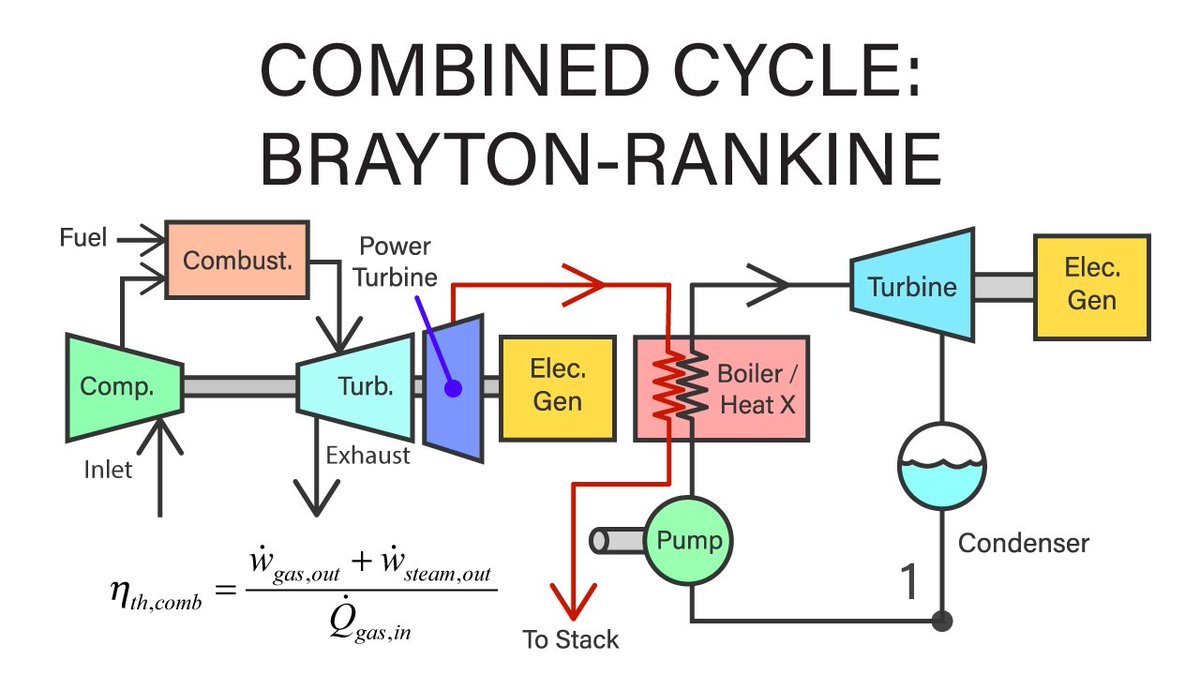
The main idea is creation of hybride:
for fusion reactor, gas-turbine (GT) based cycles provide dual advantage of high thermal conversion efficiency and significantly smaller components compared to current steam plants
for fusion reactor, gas-turbine (GT) based cycles provide dual advantage of high thermal conversion efficiency and significantly smaller components compared to current steam plants
However, coupling of combined cycle (CC) with stellarator requires some changes to plant components
Above all, combustion chamber is replaced by a heat exchanger where from reactor cooling fluid transfers thermal power to power conversion system
Above all, combustion chamber is replaced by a heat exchanger where from reactor cooling fluid transfers thermal power to power conversion system
The paper is focused on stellarator-based thermo-nuclear power plants and authors hypothesize to use a combined GT-steam PCS to convert into electricity the thermal power released by the reactor 

The power conversion system is based on the Brayton–Rankine Combined Cycle
Used supercritical CO2 for topping cycle for high efficiency and low system volume
Bottoming cycle is a 3 pressure superheated steam cycle, both with and without steam re-heating
Used supercritical CO2 for topping cycle for high efficiency and low system volume
Bottoming cycle is a 3 pressure superheated steam cycle, both with and without steam re-heating
Authors rely on a custom lumped parameter thermodynamic model implemented within MATLAB/Simscape physical modeling environment
Such a model is preparatory for optimization of system parameters: compression ratio of Brayton cycle and pressures of steam turbines
Such a model is preparatory for optimization of system parameters: compression ratio of Brayton cycle and pressures of steam turbines

The topping system is a simple-closed Brayton cycle, with single compression and expansion
The working fluid is CO2
Compression begins at 25 bar pressure and then optimize compression ratio β for maximum CC electrical efficiency (within the range in:
The working fluid is CO2
Compression begins at 25 bar pressure and then optimize compression ratio β for maximum CC electrical efficiency (within the range in:
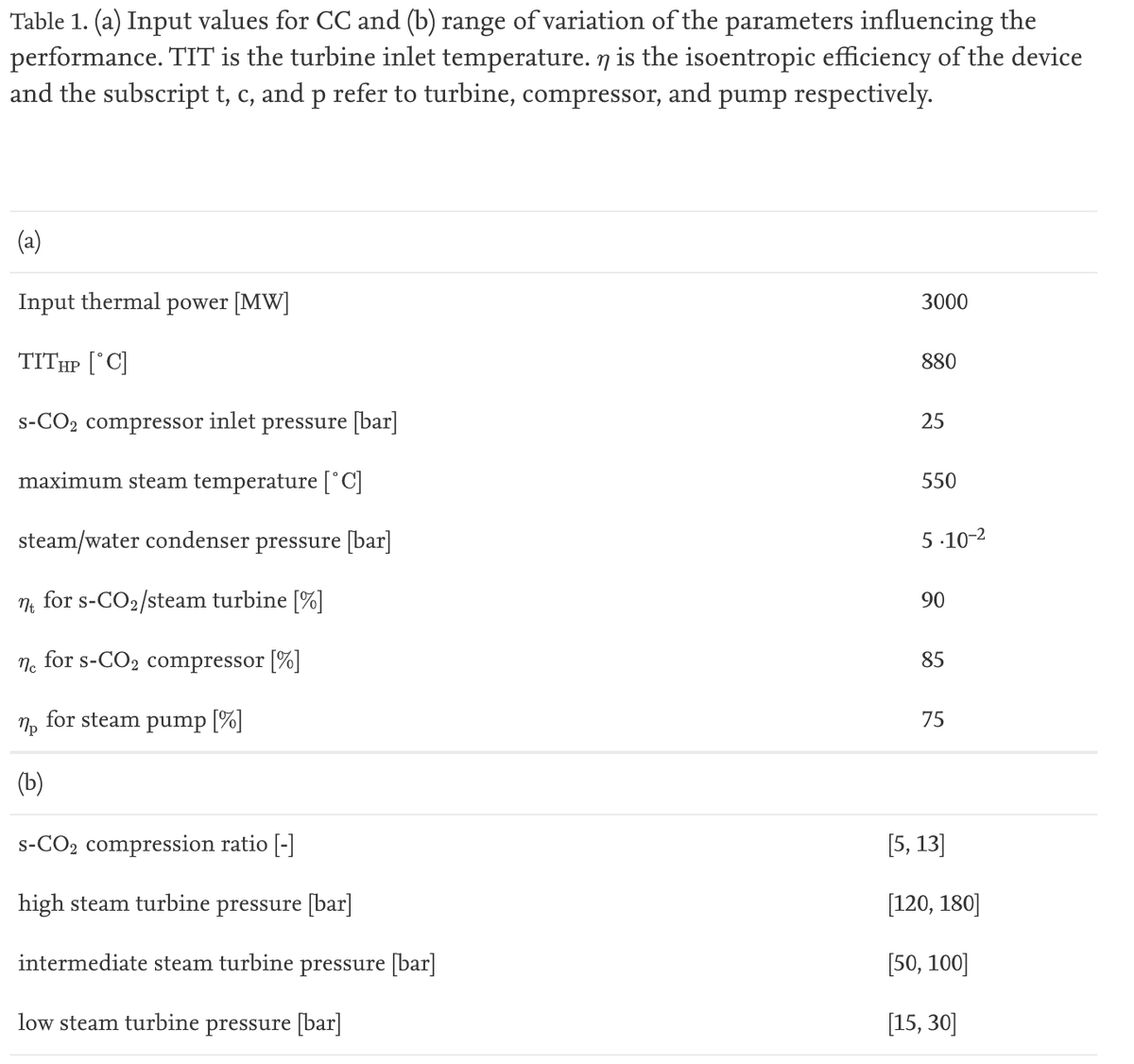
Blanket Heat eXchanger (HX) couples fusion reactor to combined cycle
Blanket utilizes Li-based liquid to extract ∼3000 MW thermal power from nuclear fusion neutrons
Here we assume that it operates at 700-900 °C temperature
CO2 turbine inlet temperature (TIT) is 880 °C
Blanket utilizes Li-based liquid to extract ∼3000 MW thermal power from nuclear fusion neutrons
Here we assume that it operates at 700-900 °C temperature
CO2 turbine inlet temperature (TIT) is 880 °C

Following experience of large scale CC plants authors select water-steam sub-critical super-heated Rankine cycle with a 3 pressure level HRSG with optional re-heating (rh)
hypothesize to use a water-cooled condenser and set its pressure to 0.05 bar
hypothesize to use a water-cooled condenser and set its pressure to 0.05 bar

The data below reports the optimal operating parameters (identified through the subscript opt) of the CC along with the corresponding global efficiency for the two analyzed HRSG configurations (i.e with and without steam reheating (rh)) 

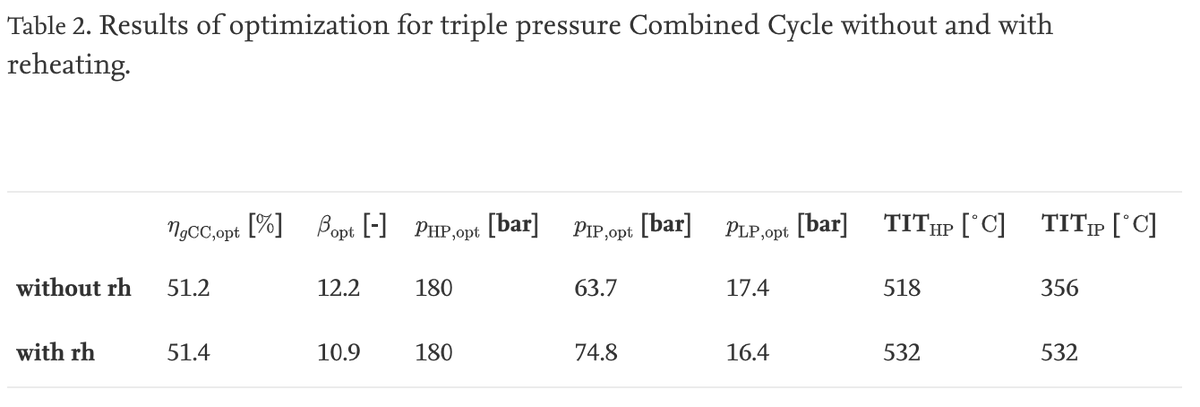

Steam reheating increases ηg CC by 0.4% (i.e. from 51.2 to 51.4%)
Bottoming cycle thermodynamic power increases from 877 MW in layout without rh to 915 MW with rh
This is mainly due to higher TIT for IP steam turbine, generated by the rh
Bottoming cycle thermodynamic power increases from 877 MW in layout without rh to 915 MW with rh
This is mainly due to higher TIT for IP steam turbine, generated by the rh
The most relevant parameter is β
CC efficiency rapidly increases with the compression ratio until reaching the optimum
ηg CC is reduced by 0.12% (without rh) and 0.13% (with rh) varying the pressure ratio from βopt to 0.85βopt
Further increasing β to 1.15 decreases ηgCC by 0.11%
CC efficiency rapidly increases with the compression ratio until reaching the optimum
ηg CC is reduced by 0.12% (without rh) and 0.13% (with rh) varying the pressure ratio from βopt to 0.85βopt
Further increasing β to 1.15 decreases ηgCC by 0.11%
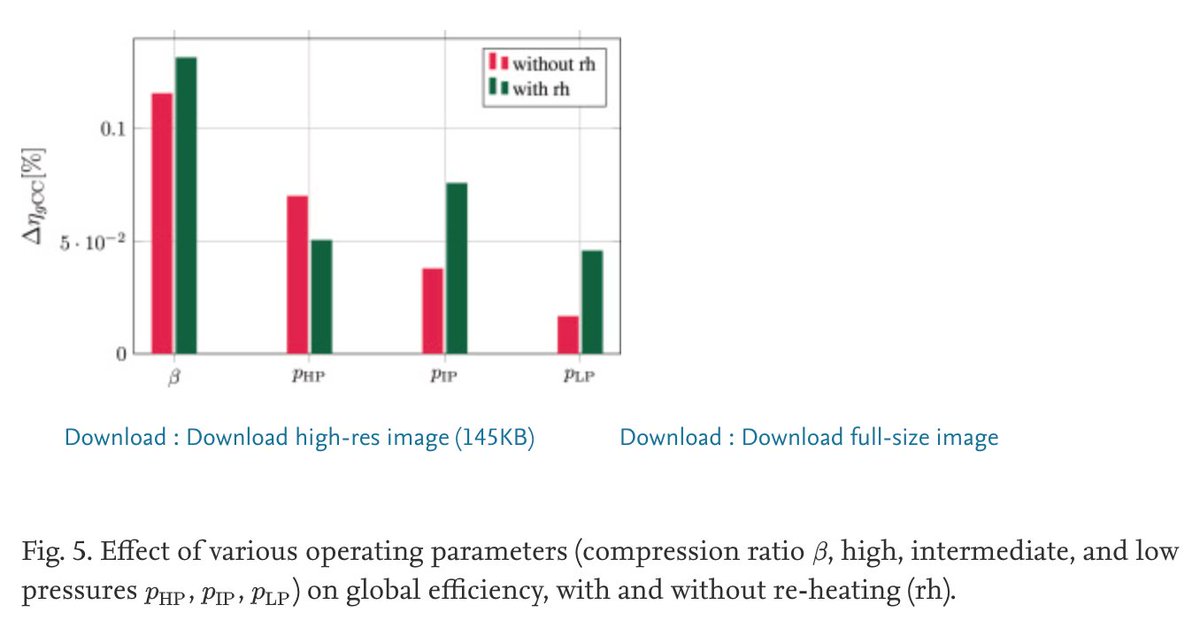
The bottoming system is conventional water-steam Rankine cycle with triple pressure HRSG
Although optimization returns higher operating pressures compared to state-of-the-art CCs, no specific design analysis is required
Although optimization returns higher operating pressures compared to state-of-the-art CCs, no specific design analysis is required
Operating parameters are well in line with widely diffused steam cycle power plants based on combustion steam generators
Such plants are also widely adopted in water-cooled fission power plants
This guarantees necessary operating experience on systems, components for licensing
Such plants are also widely adopted in water-cooled fission power plants
This guarantees necessary operating experience on systems, components for licensing
S-CO2 turbo-machinery are not exploited on commercial scale for energy production
Herein assessed technical feasibility of such an application Turbomachinery significantly affects net efficiency of system, as well as its capital and operating costs
Herein assessed technical feasibility of such an application Turbomachinery significantly affects net efficiency of system, as well as its capital and operating costs
Re-heated layout shows the highest efficiency (51.4%), about 0.37% larger compared to configuration without re-heating
Sensitivity analysis highlights:
gas turbine compression ratio is most relevant parameter,
unlike conventional combined cycles, higher is the maximum steam pressure, higher is system efficiency,
for scheme without re-heating, second most dominant parameter is high steam pressure
gas turbine compression ratio is most relevant parameter,
unlike conventional combined cycles, higher is the maximum steam pressure, higher is system efficiency,
for scheme without re-heating, second most dominant parameter is high steam pressure
The efficiency of proposed power conversion system are remarkably higher compared to state-of-the-art designs in field of thermo-nuclear fusion plants
Industrial research in this field largely focuses on tokamak-like reactors with either helium or water cooled blankets, ...
Industrial research in this field largely focuses on tokamak-like reactors with either helium or water cooled blankets, ...
...and water steam Rankine cycle based power conversion systems
The most optimistic and recent estimates foresee a heat-to-power conversion efficiency of about 34% for helium-cooled and about 31% for water-cooled reactors, without considering reactor auxiliaries
The most optimistic and recent estimates foresee a heat-to-power conversion efficiency of about 34% for helium-cooled and about 31% for water-cooled reactors, without considering reactor auxiliaries
Authors estimate stellarator internal electric power consumption (tritium plant, power supplies for the magnet, cryogenic, and pumping systems) of 486 MW thus yielding a net electrical power of 1056 MW
Considering that available thermal power at the blanket is 3000 MW, net electrical efficiency of power conversion system is 35.2% (!!!)
• • •
Missing some Tweet in this thread? You can try to
force a refresh


